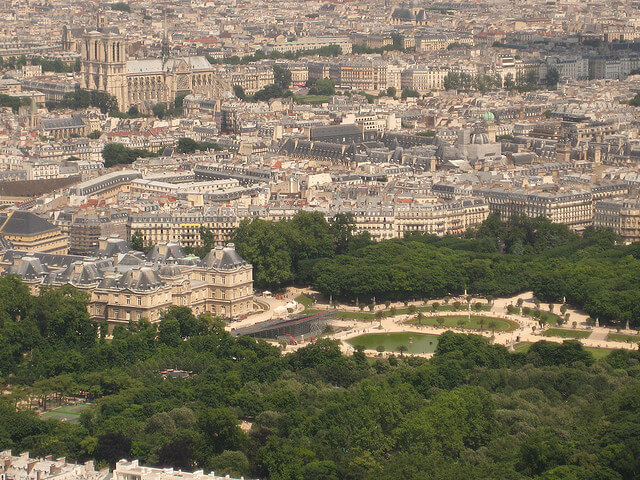Paris Arrondissements
The city of Paris is divided into 20 arrondissements, starting from the center of the city and going outwards in a clockwise spiral. If you plan on vacationing in Paris, an understanding of the general city structure can provide lots of benefits. You’ll even be able to book the most convenient hotel in relation to the tourist attraction sites you want to see most. The term ‘arrondissements’ in English is ‘districts’. Each of the districts boast different activities and historical monuments. Whether you prefer a quiet, peaceful neighborhood or one filled with nightlife and shopping, there are lots of options among the city’s 20 sections.
1st Arrondissement
Located directly in the geographical center of Paris is the 1st arrondissement. While you won’t find as many private residences in this area, its the home of historic sights such as Royal Palace, the Louvre museum, Tuileries Gardens, Bourse du Commerce and Vendome Square. If you’re interested in seeing the Conciergerie, used to imprison Marie Antoinette, or the beautiful Sainte-Chapelle, both are conveniently located in this 1st district.
2nd Arrondissement
The 2nd arrondissement, Bourse, the smallest in the city, and is known as the location of the Palais de la Bourse, the former stock exchange. While you’ll find more businesses and offices here than residential buildings, you’ll be able to get some shopping done at one of the historical shopping arcades located in this district. If catching up on some reading is in order, you can visit the National Library. The textile industry is also located in the 2nd arrondissement, so check it out if you’re a fashion designer or just looking for bargains.
3rd & 4th Arrondissement
Temple and Hotel-de-Ville, the 3rd and 4th arrondissements respectively, are the northern and southern parts of the historical Marais district of Paris. Together, they contain the Picasso Museum, Conservatoire National des Arts et Metiers, Notre Dame Cathedral, Place des Vosges and Tour St.-Jacques. If you’re in the 3rd arrondissement, you can visit the Carnavalet Museum for insight into the history of Paris, or you can hop on over to Hotel-de-Ville to go shopping in the modern Centre Pompidou. The Marais district is quite expensive, with its eclectic mix of designer and vintage shops and contrasting restaurant and dining establishments.
5th Arrondissement
The 5th arrondissement, known as the Latin Quarter, is home to the renowned Sorbonne university, and quite a few prestige universities and high schools. Some famous tourist attractions in this area are the Pantheon, Val-de-Grace church, the Cluny Museum and Jardin des Plantes, where the Natural History Museum is located. The Boulevard St-Michel forms the border between the 5th and 6th arrondissements.
6th Arrondissement
The 6th arrondissement, Luxembourg, contains the world famous Luxembourg Gardens, as well as the Odeon Theatre and churches like the Saint Sulpice and St. Germaine des Pres. The neighborhood is very popular among tourists, who frequent the many hotels in the area. Of course, the most famous sight in all of Paris, the Eiffel Tower, makes the next arrondissement one of the most visited.
7th Arrondissement
The 7th arrondissement is home to the world famous Eiffel Tower. It is also home to noteworthy tourist attractions such as the Orsay Museum, Invalides and Musee Rodin. Also in the 7th arrondissement, known as Palais Bourbon, are the Military School, UNESCO headquarters and quite a few government buildings, not to mention the area’s namesake, Palais Bourbon itself.
8th Arrondissement
Elysees, the 8th arrondissement, is one of the most expensive and exclusive in the city. You can stroll along the world renowned Champs-Elysees, stretching from Place de la Concorde to the Arc de Triomphe. You can also visit the Monceau Park, the Grand Palais and Petit Palais, and the presidential palace, the Elysee.
9th & 10th Arrondissement
The 9th and 10th arrondissements, Opera and Enclos St. Laurent are popular areas for nightlife. In Opera, you’ll find the iconic former opera house, Opera Garnier, and you can go shopping at the Lafayette Gallery, an upscale department store. Pigalle, located in the 9th, is known as the red light district and care should be taken when visiting. In the 10th arrondissement you’ll find the Gare de l’Est and the Gare du Nord, two of the city’s main metro stations, as well as the Saint Vincent de Paul church.
11th and 12th Arrondissement
Two of the more residential areas of the city are the 11th and 12th arrondissements, Popincourt and Reuilly, where you’ll be able to visit attractions such as the St. Ambroise Church, the Cirque d’Hiver or winter circus, and the Bastille Opera. These two districts are better known for their vibrant Parisian nightlife.
13th and 14th Arrondissement
Gobelins and Observatoire are the 13th and 14th arrondissements in Paris, and both offer very different experiences to travelers. The former is a residential neighborhood that is unique in that it is the location of Paris’ largest Chinatown. The latter is the home of the Montparnasse Boulevard, featuring lively nightlife and shopping opportunities. It is also the destination of tourists who want to see the catacombs or go to the nearby observatory of Paris.
15th Arrondissement
You can see the Tour Maine Montparnasse, located in the 15th arrondissement called Vaugirard, and you’re a short walk away from the Montparnasse Cemetery. Vaugirard’s size and population make it the largest arrondissement in Paris, and there’s always something to do here.
16th Arrondissement
Passy, the 16th arrondissement, has a reputation of being open only to the rich as housing is quite expensive there. When visiting the Palais de Chaillot, with its museums and movie theatre, you are afforded a breathtaking view of the Eiffel Tower. You can also explore museums such as the Musee Marmottan, and the Palais de Tokyo and Musee Guimet.
17th Arrondissement
The 17th arrondissement, Batignolles-Monceau, doesn’t offer much in the way of tourist attractions aside from its southern boulevards, but you can find the Palais des Congres convention center there. Its also the home of many artists and writers, and is a bit more affordable for renters due to its low key reputation.
18th Arrondissement
Arrondissement 18, Butte-Montramarte, is where you’ll find the infamous Moulin Rouge cabaret show, as well as the popular tourist attractions Sacre Coeur Basilica and the Place du Tetre. Here, you’ll be able to enjoy traditional French architecture that has remained largely unchanged, aside from a few modern conveniences here and there.
19th & 20th Arrondissement
The last two arrondissements, Buttes-Chaumont and Menilmontant, don’t offer much in the way of tourist attractions, but some of the city’s best parks can be found here. The Parc des Buttes-Chaumont and the Parc de la Villette are worth visiting, especially if you want to explore the city’s science museum located in the latter. The 20th arrondissement is mainly a residential area, and there’s nothing much to do there unless you plan on visiting Paris’ most famous cemetery, the Cimetiere du Pere-Lachaise. You’ll be able to do some shopping in the area though, as it does feature some markets and shops that may appeal to tourists looking for a day of shopping.
Photo by Guillaume Cattiaux


